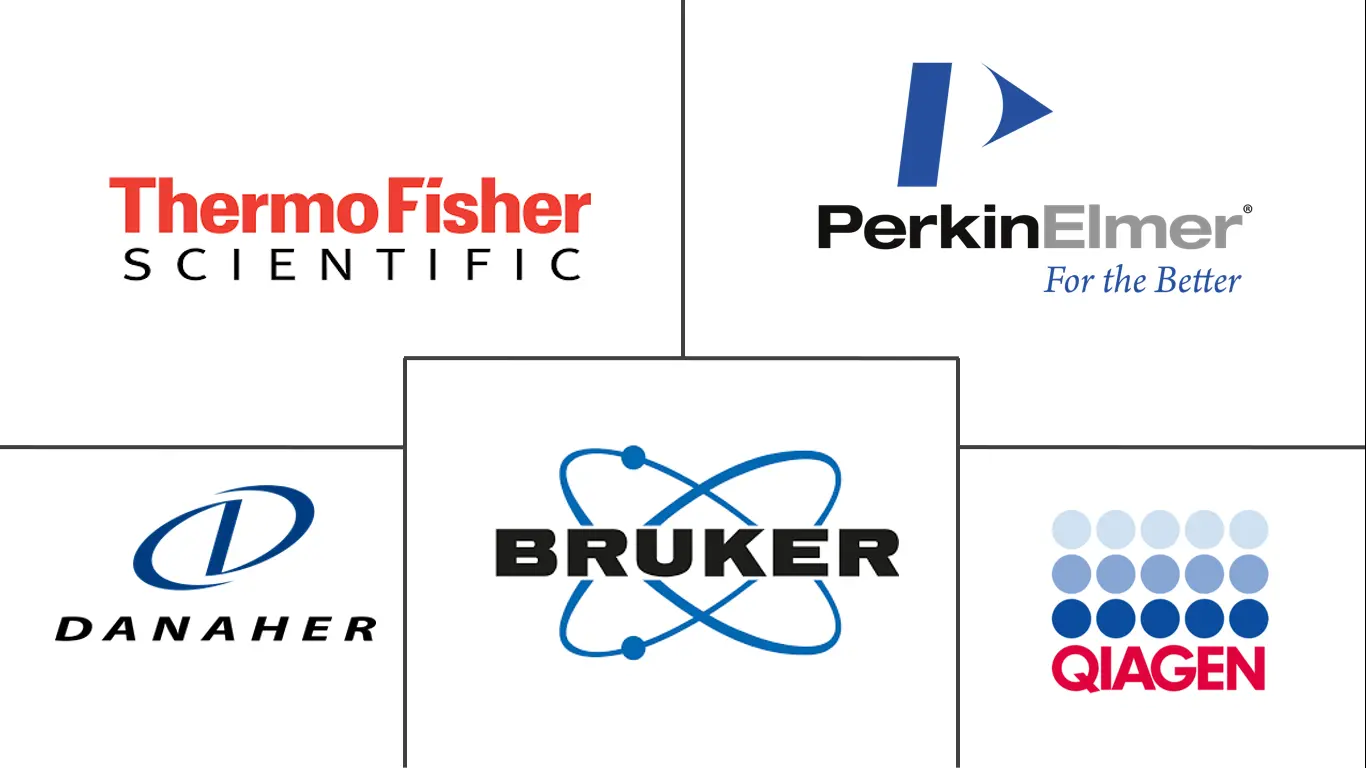Molecular Robotics Market Size and Share
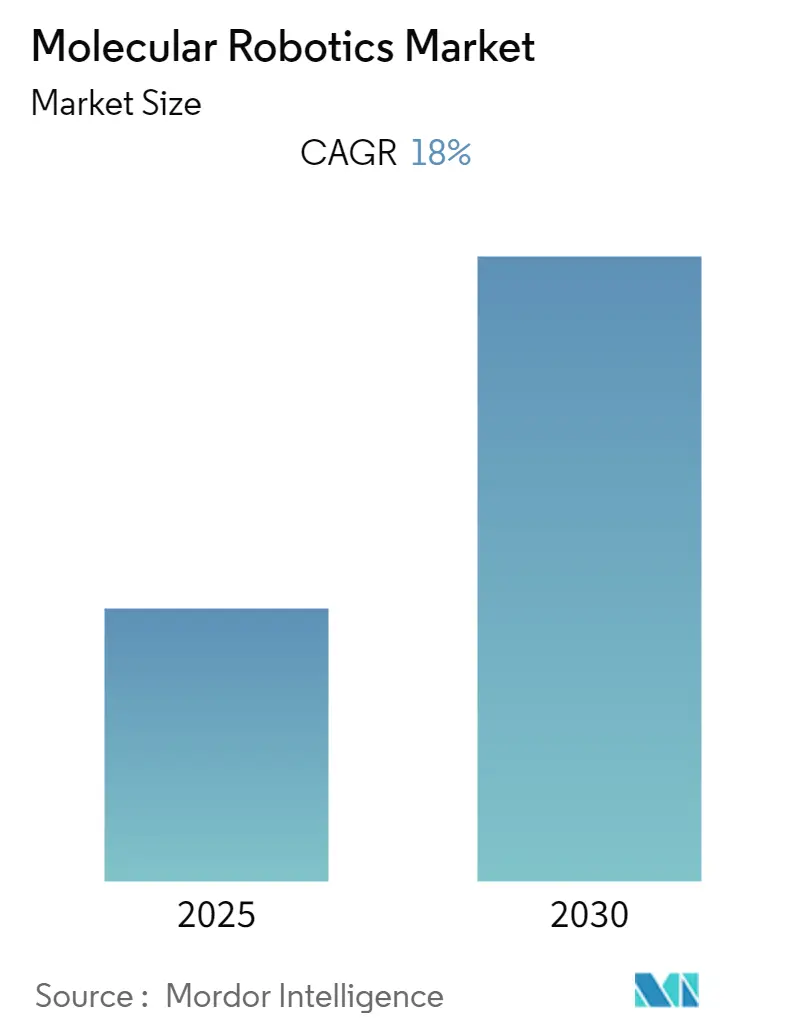
Molecular Robotics Market Analysis by Mordor Intelligence
The Molecular Robotics Market is expected to register a CAGR of 18% during the forecast period.
After the outbreak of COVID-19, all markets were significantly affected due to supply chain disruptions. However, research and development were increased to find potential treatments for the COVID-19 infection. The demand for research and development in molecular robotics has increased because it can enable fast and smart treatment options by changing molecules. Many research studies have been conducted to find better patient care and treatment options. In an article published in the British Medical Journal in August 2021, it was mentioned that researchers developed a robotic nucleic acid extraction method for high-throughput detection of SARS-CoV-2 RNA in saliva samples. More research and studies have also been done to find a cure for COVID-19. These research and studies have created a demand for molecular robots and have had a positive impact on the market under review. However, currently, the market is growing at a stable pace owing to rising research and development activities, and it is expected to witness a similar trend over the coming years.
The high prevalence of chronic diseases such as cancer and other rare diseases and increased use in drug development are the major driving factors for the molecular robotics market. For instance, according to the Breast Cancer Factsheet Now 2021, around 55,000 women and 370 men in the United Kingdom are diagnosed with breast cancer every year. This figure is expected to climb to 1.2 million by 2030. This rising incidence of cancer leads to increased demand for advanced technology. As molecular robots can read, edit, and alter DNA and RNA, which can create new structures to find a cure for cancer-like diseases, the demand for these molecular robots is increasing, which is expected to lead to the growth of the market during the forecast period.
As research and development have been on the rise lately, laboratory automation is becoming a need to maintain a smooth workflow. Molecular robots are designed using advanced technologies to minimize the pressure of learning new software and other equipment, helping scientists increase the overall efficiency of their laboratories and accelerate next-generation research. In July 2022, Researchers created new DNA motors that can sense and process chemical information, allowing them to respond quickly and mimic some fundamental properties of living cells. With new research producing the first DNA-based motors that combine computational power with the ability to burn fuel and move in an intentional direction, the inspiration for miniature molecular robots is rising exponentially. This is expected to gain demand and boost the growth of the studied market during the forecast period.
However, the high cost of development and design of these molecular robots is expected to restrain the growth of the market over the studied forecast period.
Global Molecular Robotics Market Trends and Insights
Drug Discovery by the Application Segment is Expected to Witness a Healthy Growth Over the Forecast Period
The rapid progress of molecular nanotechnology has opened the door to advanced technologies such as molecular robotics. This technique uses molecules as parts of robots. Drug discovery has gained demand due to the increasing incidence of chronic and rare diseases. Because drug discovery takes time, researchers are now focusing on using molecules as robots and introducing molecular robotics into the drug discovery platform.
According to the study published in Springer Nature's Molecular Robotics in February 2021, advances in DNA nanotechnology are increasing the demand for molecular robots made of biomolecules. The same source also stated that these molecular robots can carry drugs with sophisticated information processing capabilities and can also be used for theranostics (a term used for therapy and diagnosis). This growing R&D in drug discovery and the application of molecular robotics in drug discovery are increasing the demand for molecular robots, which is expected to boost the growth of the studied market in this segment.
The increasing number of experiments, clinical trials, and fundraisers in the field of drug discovery for the application of biomolecular robots is currently increasing the growth of the studied market. For instance, in June 2022, Insilico Medical announced the completion of a USD 60 million Series D fundraising from a syndicate of global investors with experience investing in the biopharmaceutical and life sciences industries. The funding aims to invest in the launch of an AI-powered drug discovery robotics laboratory and construct unique molecular structures with desired features.
Therefore, the increasing activities by the research organizations and the major market players are driving the growth of the drug discovery segment. This is expected to contribute to the studied market's growth over the forecast period.
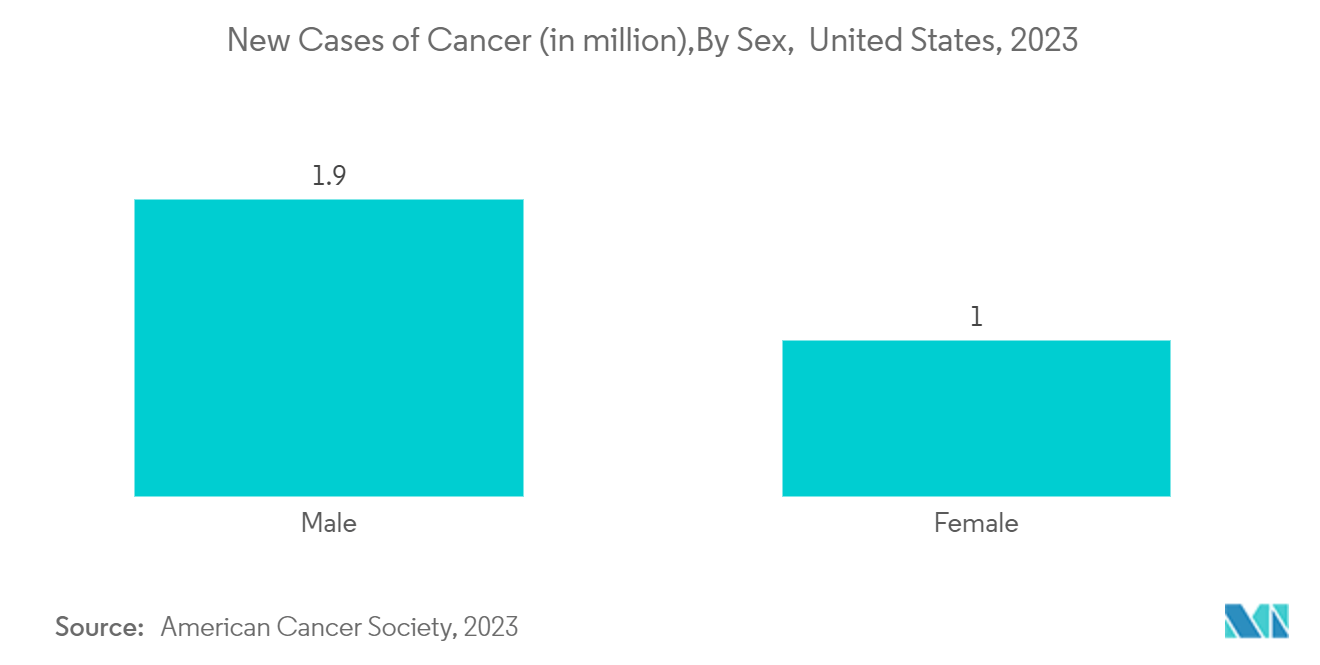
North America Holds Significant Share in the Market and Expected to Grow in Forecast Period
North America is expected to dominate the molecular robotics market, and the market is expected to grow in the region due to advanced robotics technologies and increased research and developments in the pharmaceutical sector. The prevalence of chronic diseases, such as cancer and other rare diseases, has recently been increasing in North America. In North America, especially in the United States, research and studies are leaning toward finding better and more advanced drug and treatment options.
According to Cancer Facts and Figures 2023, published in January 2023 by the American Cancer Society, an estimated 1.9 million new cancer cases will be diagnosed in 2023, among which prostate cancer is estimated to be among 288,300, followed by 238.340 cases of lung cancer and 300,590 cases of female breast cancer. Furthermore, according to statistics published by the Government of Canada and released in May 2022, about 233,900 Canadians were diagnosed with cancer in 2022, and prostate cancer is expected to remain the most commonly diagnosed cancer. Cancer cases motivate research institutes in the United States to collaborate with research institutes in other North American countries. This collaboration is involved in finding the best cure for cancer. Molecular robots are one of the most studied tools for cancer drug discovery research in the region.
The presence of a high concentration of market players in the North American region and new product launches by these players are also driving the growth of the market in the region. Active participation of universities in drug research and molecular robotics is also supporting the growth of the studied market. For instance, in November 2021, Harvard University's Wyss Institute for Biologically Inspired Engineering, along with the University of Vermont and Tufts University, announced that a team of researchers known to have built the first living robot, the Xenobot, had discovered an entirely new form of biological reproduction of this living robot, which promises numerous opportunities for regenerative medicine development. The advanced research and developments in the region are anticipated to spur the growth of the studied market over the forecast period.
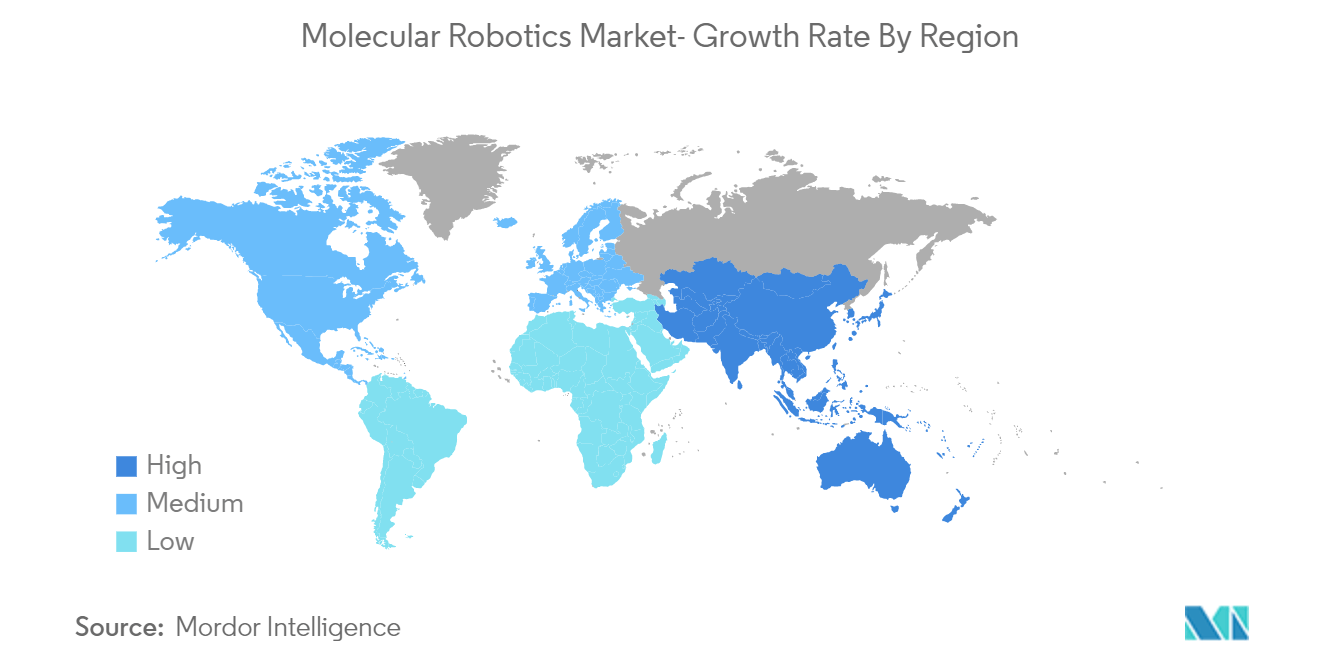
Competitive Landscape
The molecular robotics market is moderately competitive. Some of the companies currently dominating the market are Danaher Corporation (Medical Devices LLC), Bruker, Thermo Fisher Scientific, Qiagen, PerkinElmer Inc., and Zymergen Inc., among others. These major players hold a significant share in the industry. Most of the players focus on bringing technologically advanced products into the market to acquire the maximum market share.
Molecular Robotics Industry Leaders
-
Bruker
-
Danaher Corporation (Medical Devices, LLC.)
-
PerkinElmer
-
Qiagen
-
Thermo Fisher Scientific
- *Disclaimer: Major Players sorted in no particular order
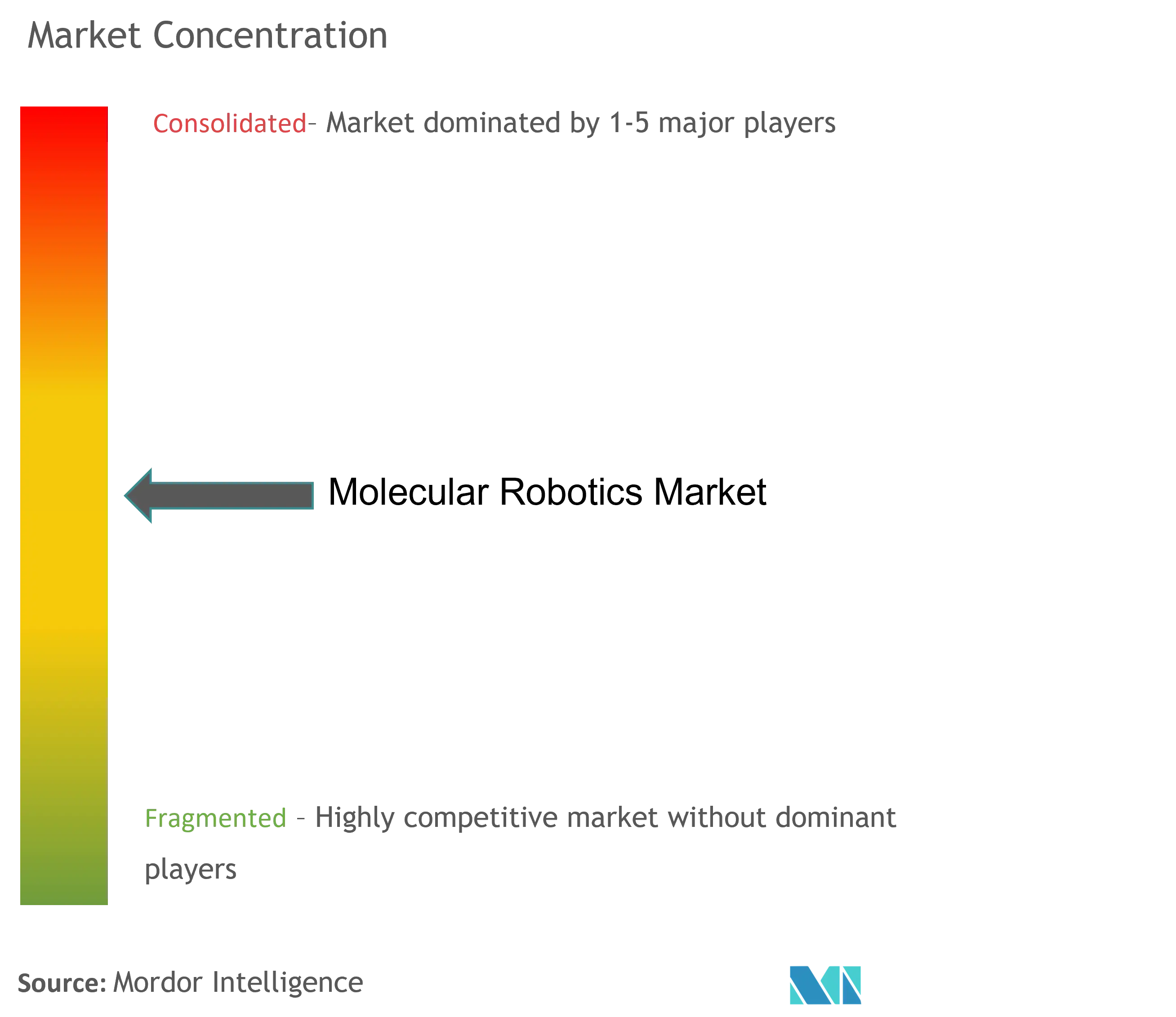
Recent Industry Developments
- Jan 2023: Insilico Medicine launched the 6th generation Intelligent Robotics Lab to further accelerate its AI-driven drug discovery. The fully automated AI-powered robotics laboratory performs target discovery, compound screening, precision medicine development, and translational research. The lab will allow Insilico to further accelerate its end-to-end drug discovery and optimize the success rate of its drug development as it moves its novel therapeutics through clinical trials.
- Jan 2022: Frost & Sullivan recognized Insilico Medicine with the 2021 Entrepreneurial Company of the Year Award in the global AI-enabled drug discovery industry.
Global Molecular Robotics Market Report Scope
As per the scope of the report, molecular robots are designed and capitalized using advanced technologies to automate scientific workflow easily while minimizing the hassle of learning new software and equipment. These molecular robots are also suited for a wide variety of research fields, including synthetic biology, drug discovery, and biotechnology.
The Molecular Robotics Market is Segmented by Product Type (Software and Consumables, and Devices), Application (Drug Discovery, Genetic Research, and Other Applications), End User (Research Laboratories and Pharma and Biotech Companies), and Geography (North America, Europe, Asia-Pacific, Middle-East and Africa, and South America). The report also covers the estimated market sizes and trends for 17 countries across major regions globally. The report offers the market size in value terms in USD for all the abovementioned segments.
| Software and Consumables |
| Devices |
| Drug Discovery |
| Genetic Research |
| Others |
| Research Laboratories |
| Pharma and Biotech Companies |
| North America | United States |
| Canada | |
| Mexico | |
| Europe | Germany |
| United Kingdom | |
| France | |
| Italy | |
| Spain | |
| Rest of Europe | |
| Asia-Pacific | China |
| Japan | |
| India | |
| Australia | |
| South Korea | |
| Rest of Asia-Pacific | |
| Middle East and Africa | GCC |
| South Africa | |
| Rest of Middle East and Africa | |
| South America | Brazil |
| Argentina | |
| Rest of South America |
| By Product Type | Software and Consumables | |
| Devices | ||
| By Application | Drug Discovery | |
| Genetic Research | ||
| Others | ||
| By End-User | Research Laboratories | |
| Pharma and Biotech Companies | ||
| Geography | North America | United States |
| Canada | ||
| Mexico | ||
| Europe | Germany | |
| United Kingdom | ||
| France | ||
| Italy | ||
| Spain | ||
| Rest of Europe | ||
| Asia-Pacific | China | |
| Japan | ||
| India | ||
| Australia | ||
| South Korea | ||
| Rest of Asia-Pacific | ||
| Middle East and Africa | GCC | |
| South Africa | ||
| Rest of Middle East and Africa | ||
| South America | Brazil | |
| Argentina | ||
| Rest of South America | ||
Key Questions Answered in the Report
What is the current Global Molecular Robotics Market size?
The Global Molecular Robotics Market is projected to register a CAGR of 18% during the forecast period (2025-2030)
Who are the key players in Global Molecular Robotics Market?
Bruker, Danaher Corporation (Medical Devices, LLC.), PerkinElmer, Qiagen and Thermo Fisher Scientific are the major companies operating in the Global Molecular Robotics Market.
Which is the fastest growing region in Global Molecular Robotics Market?
Asia-Pacific is estimated to grow at the highest CAGR over the forecast period (2025-2030).
Which region has the biggest share in Global Molecular Robotics Market?
In 2025, the North America accounts for the largest market share in Global Molecular Robotics Market.
What years does this Global Molecular Robotics Market cover?
The report covers the Global Molecular Robotics Market historical market size for years: 2019, 2020, 2021, 2022, 2023 and 2024. The report also forecasts the Global Molecular Robotics Market size for years: 2025, 2026, 2027, 2028, 2029 and 2030.
Page last updated on:
Molecular Robotics Market Report
Statistics for the 2025 Molecular Robotics market share, size and revenue growth rate, created by Mordor Intelligence™ Industry Reports. Molecular Robotics analysis includes a market forecast outlook for 2025 to 2030 and historical overview. Get a sample of this industry analysis as a free report PDF download.
